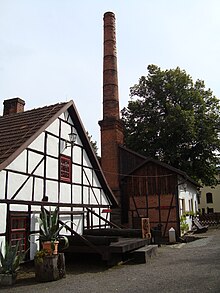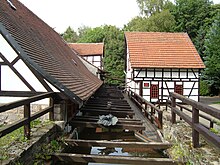TheTobiashammeris a large, water-drivenhammer millinOhrdrufin the German state ofThuringia.The mill, which dates to 1482, has been an industrial monument and museum since 1983.




History
editThe first hammer forge was probably built in 1482[1]on the RiverOhra.In 1592 the mill was bought by Tobias Albrecht, since when it has been named after him. The works originally had three huge iron hammers which were raised by the motion of awater wheel.
The mill made iron products such asscythes,sickles,ploughshares,lancesandswords.Later, it also carried outcopperprocessing;washbowls,washtubs,kettle drums,brewing implements, pots, cans and pans were made. The kettle drums, which were produced into the late 20th century, were made from a single piece of copper, forged under thetilt hammerand still set a standard today in terms of their sound.
The Tobiashammer was owned by the Albrecht family until 1816 when they sold it. Thereafter its owners changed more often. From the mid-19th century the mill was significantly enlarged. Arolling milland a second hammer mill was built. The office (Kontorhaus), built in 1882, now acts as a restaurant, theHammerschenke.
In 1972 the old, ruined hammer mill was bought from private owners by the Ohrdruf Steelworks.
In 1983 the Tobiashammer was opened to the public as a demonstration mill.
Museum, technology and art
editThe museum has five workingtrip hammers,arolling mill,stamp milland grinding workshop as well asfurnaces.The mill is still driven by fourwater wheels.
Since 1988 the Tobiashammer has also housed one of the largeststeam enginesin Europe: a twin, tandem, reversing, steam engine, built in 1920, with a total weight of 305 tonnes and a power output of 12,000 horsepower. It comes from the oldMaxhüttesmeltery atUnterwellenbornand was decommissioned in 1985. The engine is fully working and is operated during guided tours.
An annual event that has taken place since the museum's opening in 1983 is the Blacksmiths’ Symposium (Schmiede-Symposium). In 2009 it was entitled"Tribute to Fritz Kühn"and brought together ornamental metalsmiths from three continents. Over the years many well-knownmetalsmithsand metal sculptors have created theirworks of arthere. Many still grace the outer areas of the museum site as part of its sculpture park, such as the gigantic, forged water lily by Alfred Habermann andDas Gesichtby Rüdiger Roehl.
References
edit- ^"Thüringen-ReporterArchived2012-09-11 at theWayback Machinedated 29 April 2012, mit Hinweis 1482 u. Schmiedesymposium. Retrieved 13 May 2013.
Literature
edit- Wolfgang Schmidt, Wilfried Theile:Denkmale der Produktions- und Verkehrsgeschichte. Teil 1.VEB Verlag für Bauwesen, Berlin, 1989,ISBN3-345-00312-0
- Eberhard Wächtler:Tobiashammer Ohrdruf.Stahlverformungswerk Ohrdruf, 1987
- Manfred Beckert:Metallgestaltung im Tobiashammer.25 Jahre Metallgestalter-Symposium im Tobiashammer, Steinbeis-Edition 2008,ISBN3-938062-29-0
- Tobiashammer: ein Kunstbuch.Verlag für Schweißen und Verwandte Verfahren, DVS-Verlag, 1999